Semah Laut: Cultural Exsistence for Sustainable Living of Karimata Islanders in Tanah Betuah North Kayong Regency, Indonesia
Abstract
The culture of the archipelago is formed through the culture and traditions of regional communities. The local traditions of each region have distinctive characteristics that form an identity that distinguishes it from other communities. The preservation and meaning of semah laut from Karimata Island in Tanah Betuah North Kayong Regency is an urgency to study. The ethnographic research method uses a qualitative approach to examine the preservation and meaning of the semah laut tradition of the Karimata island community. The data sources used in this study include key informants, namely the elders of the Karimata Islands community who are obtained through dept interviews. The results showed that semah laut was carried out as proof of obedience and thanksgiving to God for all the abundance that had been given for one year and as a prayer to be given an abundance of sea products in the coming year. Both the implementation and traditional equipment become the basis of their lifestyle that must be preserved. As a religious community, they always worship and obey God. Simplicity becomes their lifestyle so that life is adjusted to their needs and abilities. Mutual cooperation must always be done to make the tradition implemented well and neatly.
Keywords
Indigenous knowledge, Local community, Local culture, sustainability
Introduction
The archipelago is unique to Indonesia and known as the largest archipelago in the world. According to data from the Directorate General of Public Administration-Depdagri, Indonesia consists of 16,771 islands, and 6,056 of them have names recorded at the United Nations, 1,331 ethnic groups, and boasts an 81,000 km-long coastline. Indonesia has 4,735 coastal villages that are rich in maritime cultures (Kepel et al., 2024). Indonesia is also a densely populated country. Indonesian people live and spread across various islands in Indonesia, including small islands in Indonesia. Therefore, the Indonesian people who live in a group of small islands are known as an archipelago community. Archipelagic country, a uniqueness embedded in Indonesia, provides space to understand the lifestyle of island communities (Sulistiyono et al., 2023). Archipelagic communities have a unique and intact relationship between the sea, land and natural phenomena on the islands. As a consequence, it will form a system of traditions, customs, cosmology, and beliefs that become a milestone of existence for island communities (Juliana et al., 2023; Watloly, 2012). This indicates that each island community has the space to maintain their identity because they cannot be separated from their island. Indonesian culture is formed from various traditions, including the traditions of island communities that are still preserved (Izzah et al., 2022; Nainggolan et al., 2023).
The coast of West Kalimantan has an area of about 51,857.36 km2, spread over several islands and small islands, one of which is the Karimata archipelago which is under the auspices of the North Kayong government (Kurniadi et al., 2023). One of the interesting islands in Indonesia is in West Kalimantan Province, namely the Karimata islands. Karimata Island is one part of Tanah Betuah North Kayong. It is named Tanah Betuah, due to its beauty and abundance of natural products. The geographical location has a sufficient impact to maintain the natural beauty and preservation of traditions on Karimata Island. The natural beauty of Karimata Island is seen from the abundant natural products of the sea. The land of Karimata Island is a place to live for the community and they have a close relationship with the sea, because most of the islanders work as fishermen and depend their lives on the sea.
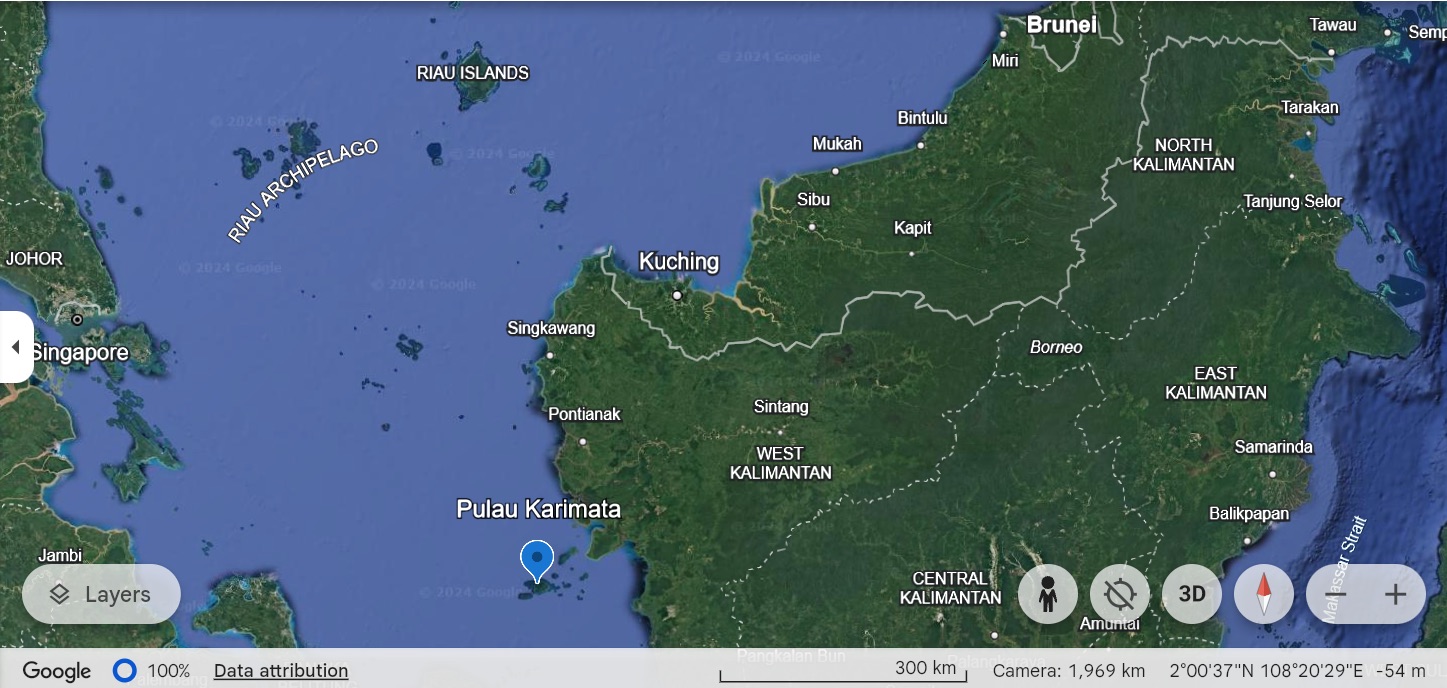
The people of Karimata Island live side by side with the beautiful nature and maintain their ancestral traditions from generation to generation. As the largest island in the archipelago, Karimata has a strategic geographical location, between the islands of Kalimantan and Sumatra, and as a link between the Natuna Sea and the Java Sea. However, access to the island is rather difficult due to shallow and craggy waters, which makes its natural beauty preserved. Thus, the Karimata islands are a unique blend of cultural wealth and unspoiled natural beauty.
Research conducted by Hidayati & Tangkudung shows that the Karimata islands in North Kayong have a beautiful coastal area (Hidayati & Tangkudung, 2021). This beauty can be seen from the maritime beauty of the small islands around Karimata and also cultural attractions. These islands have a variety of cultures that can build Indonesia's cultural pluralism. This is due to the existence of various tribes that bring with them their respective traditions and beliefs. Customs that are thick with religious magical elements have become an integral part of people's lives.
Humans as cultured beings are the basis for the formation of a cultured society. Tradition after tradition continues to be passed down and lasts hundreds to thousands of years. This also applies to the people of the Karimata islands. The Karimata Islands in North Kayong, West Kalimantan with a variety of cultures build Indonesian cultural pluralism. North Kayong is formed from various tribes that bring their own culture. The magical religious customs of indigenous life that include interrelated rules become a system in the wrapping of customs. Humans as cultured humans are the basis for the formation of a cultured society. Tradition after tradition continues to be passed down and lasts hundreds to thousands of years. Traditions that have meaning for the sustainability of the life of a society must continue to be preserved.
One tradition that still exists today is the Semah Laut tradition. This tradition is passed down from generation to generation and has survived for centuries in the Karimata islands. The Semah Laut tradition in the Karimata Islands is a tangible manifestation of the community's gratitude for the abundance of sea products (Sakdiyah et al., 2023). As a community that depends on marine products, this tradition has become an inseparable part of people's lives. This tradition is a form of respect for nature and as a prayer for safety. Similar traditions exist in several regions in Indonesia that have 4,735 coastal villages, including the Bantik Community with the Gocefa tradition (Kepel et al., 2024), sedekah laut (Amanatin et al., 2024), Larung Sesaji (Mellina et al., 2022), Tuturangiana Andala (Mildawati & Syahrun, 2023), Petik Laut Muncar (Nurmalasari, 2023).
The Semah Laut tradition has become a strong social institution in the Karimata archipelago community. As expressed by (Fauzi et al., 2021), “This Semah Laut is the ecosophy of the Malay people in this area towards the natural environment.” This tradition is not only an expression of gratitude, but also a social glue that unites the community in preserving the marine environment. As a community that lives side by side with the sea, the Semah Laut tradition has become part of the identity and noble values of the Karimata community. The semah laut tradition is also carried out in Riau, precisely in the Panglong sea tribe community of Bintan, Riau Islands. Although it has the same name, the function of this tradition is different, in Riau Islands it functions to protect the sea and coral reefs (Swastiwi et al., 2024). However, in Kepualan Karimata it functions as a thank you to God.
The noble values of the semah laut tradition have become a sustainable lifestyle for the Karimata community. In line with the explanation from the Indonesian Ministry of Education and Culture Research and Technology that culture is the source and result of development. The idea is emphasized because human life in the global order is still considered far from sustainable living (Firdaus, 2022; Kemdikbud, 2022). States that in the era of the onslaught of globalization that keeps people away from their culture until the loss of their personality (Mialiawati, 2020). Implementing and interpreting local wisdom well in community life, the sustainability of the earth will be maintained which is utilized in clothing, food, and shelter. The involvement of the younger generation is very important in maintaining local cultural traditions amid the phenomenon of globalization. It is important to engage older and younger community members in intergenerational conversations to facilitate this knowledge transfer and ensure the preservation of cultural identity (Radović-Marković et al., 2019). From the many studies of semah laut, it always examines semah laut as a tradition, and also the preservation of traditions. The study of this research is different from other studies, which is about how the tradition of semah laut becomes a sustainable pattern of life for the Karimata people who are very dependent on the inland sea in their lives.
An in-depth study of the semah laut tradition is important to be carried out considering the urgency of this research is related to the preservation of the tradition and the meaning of the semah laut tradition in the life of the community. This tradition not only reflects the harmonious relationship between humans and nature, but also contains noble values that need to be passed on to future generations. By understanding the deep meaning, it will be possible to understand the symbolic things hidden behind every ritual and practice.
Material and Methods
Qualitative research method with an ethnographic approach to examine the preservation and meaning of the semah laut tradition into a sustainable lifestyle in the Karimata Islands community. The data sources used in this research include key informants, namely the elders of the Karimata Islands community, as well as other informants obtained after conducting interviews with key informants. Sources of data in the form of events and places related to the activities of the tanah betuah tradition. Document data sources that will be collected include documents at the research location including cultural objects used in the daily lives of local residents. This research emphasizes the results of interviews and phenomena that occur in the community (Sari et al., 2023; Yahya, 2019).
The document data to be collected includes data at the research location including cultural objects used in the semah laut ritual procession. These data are obtained through interviews and observations. This is as revealed by (Jailani, 2023), that in qualitative research generally uses interview techniques that will involve direct interaction between researchers and informants, namely traditional elders who become shamans and people involved in the implementation of the semah laut ritual. While observation is carried out by directly observing the research subject used to collect data on behavior, interactions, or phenomena observed in this case what is observed is the Semah Laut tradition including the materials used during the ritual procession. By using these techniques, the cultural values contained in the tradition are analyzed more deeply and the preservation of the semah laut tradition is also described.
The source of data in this study, namely key informants who are elders from the community in the Karimata Islands. The data were obtained through participant observation techniques by means of in dept review with researchers as human instruments, observation, and document analysis which are the main techniques for finding and studying problems in the field (Purmintasari et al., 2021). Data will be stopped when the data has reached the saturation point. Apart from interviews, data were also obtained based on direct observation.
Qualitative data analysis that will be used in this research is the process of turning data into findings by interpreting the data collected (Purmintasari et al., 2021). Data analysis in qualitative research begins with grouping the same data, then interpretation is carried out to give meaning to each subaspect and the relationship between one another. Then the analysis or interpretation of all aspects is carried out to understand the meaning of the relationship between one aspect and another which is the focus of the research. The meaning is interpreted in analyzing the data from the informant's point of view where the research is carried out (Purmintasari et al., 2021). This research analyzes the meaning and sustainability of the semah laut tradition. The ethnographic approach is used to analyze this research, because it is related to traditions that are the culture of community life in the Karimata archipelago, especially data related to the procession, meaning, and form of preservation of the semah laut tradition in the Karimata Islands.
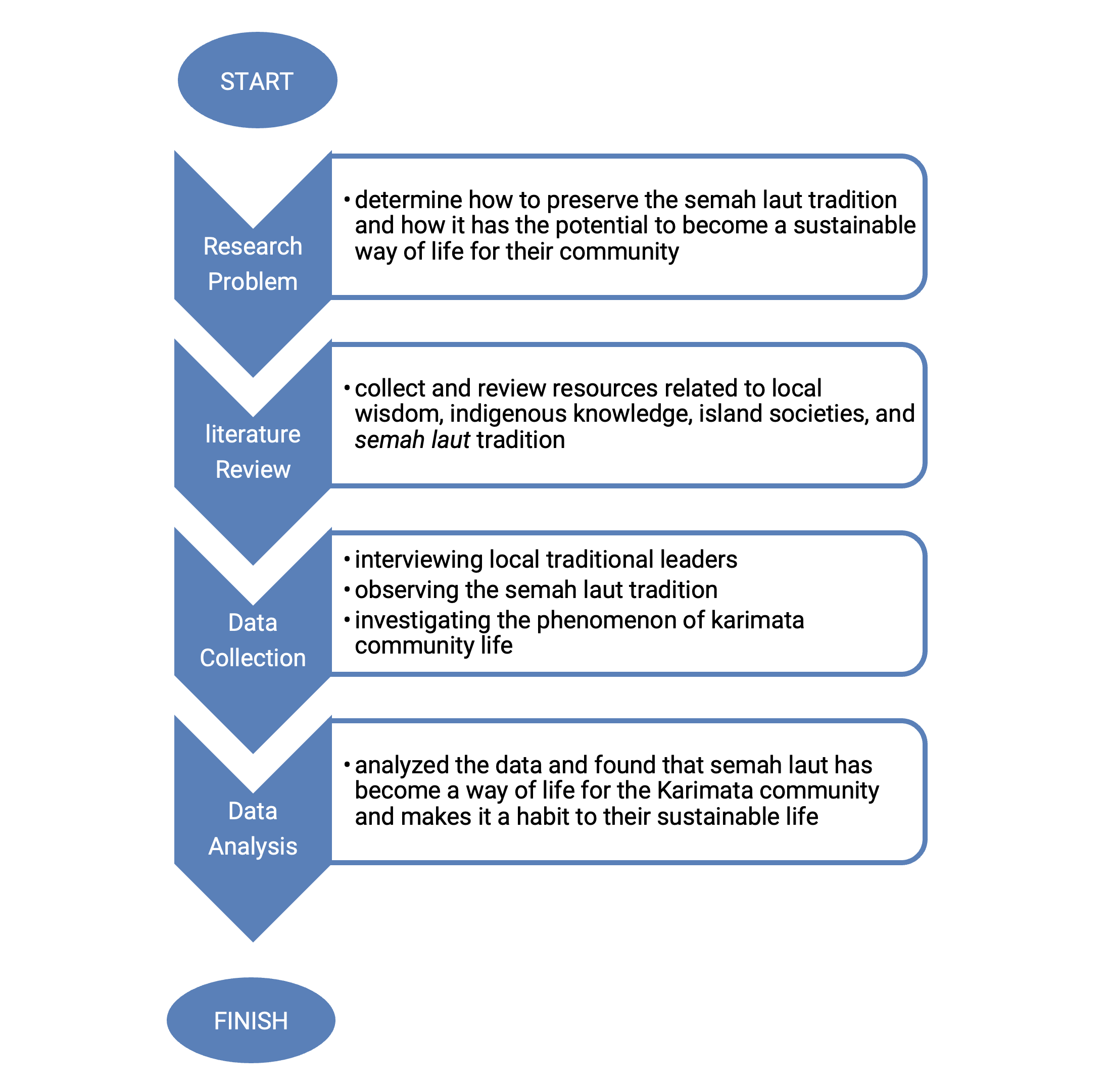
Result and Discussion
A. Tradition Preserved
Semah laut is a ritual offering to the land (island) and the sea to express gratitude for what they have received so far, the land as a place to live and the sea as a place to find food (WP, 2022). Semah laut tradition is routinely held every April 4 because it is traditionally held on that date. Semah laut should not be held outside of that date because it will have an impact on sea catches or disturbances to the Karimata Community. The date of the activity coincides with the end of the fish season, especially mackerel. Semah Laut tradition requires a balai which symbolizes a place to live on land, a jung which symbolizes a means of transportation at sea, ancak as a place to store pottery which will later be included in the balai and jung (Komarudin, 2023a, 2023b). The traditional equipment is prepared by the shaman who will lead the ritual (Tim Dinas Kepemudaan, 2023). Semah laut equipment is placed in the heritage house of Tengku Abdul Jalil in Pantai Lestari Hamlet, Padang village. The activity begins at night marked by the sound of gongs and drums. The Semah Laut ritual procession on Karimata Island begins at 7.30pm with the sound of music from two traditional percussion instruments, the drum and gong. These two instruments often accompany various village rituals. Amidst the sounds of the drums and gongs and the excitement of the participants and spectators, an old man around 60 years old approached a miniature jung or sailboat. This old man, one of the most respected shamans on Karimata Island, is followed by a middle-aged man who may also be a shaman, carrying a bokor full of smoke from the flame of coconut husks and other materials.
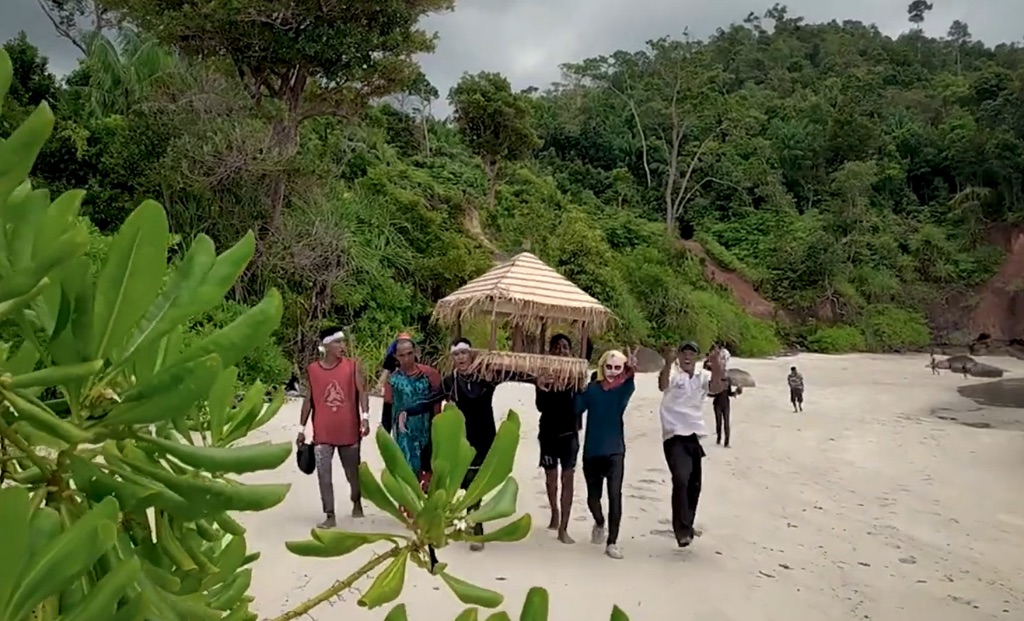
The elder shaman takes yellow rice from a bag, smokes it over the smoke of the bokor, and inserts it into certain parts of the miniature jung. Not long after, an elderly woman who is also a shaman does the same with other offering materials brought by another man beside her. These offerings consist of various types of food representing seven different types and colors. After the old woman has placed the offerings into the miniature jung, the first stage of the procession is complete, describing the making of offerings to the miniature jung that will be floated the following day. The next activity is a speech from community leaders, the acting Head of Padang Village, and the Regent of North Kayong who are present that night. After the speeches were over, someone approached the elder shaman, Pak Usu, to ask permission to continue the next procession. Several elders and shamans, including Pak Usu, surround and smoke the miniature junk with smoke from a bokor. After the procession is complete, Pak Usu sows yellow rice in all directions around the miniature junk. At the same time, several people, dressed from the start in costumes like ethereal beings, begin to dance around the miniature jung to the sound of drums and gongs. Their movements seemed disorganized but more and more people joined in, including youngsters in similar outfits. They lift the miniature jung and balai in dance moves that depict the joy and rejoicing of the spirits at a feast. The dance also involves the audience and officials present, so that the atmosphere of joy and excitement is felt by all present.
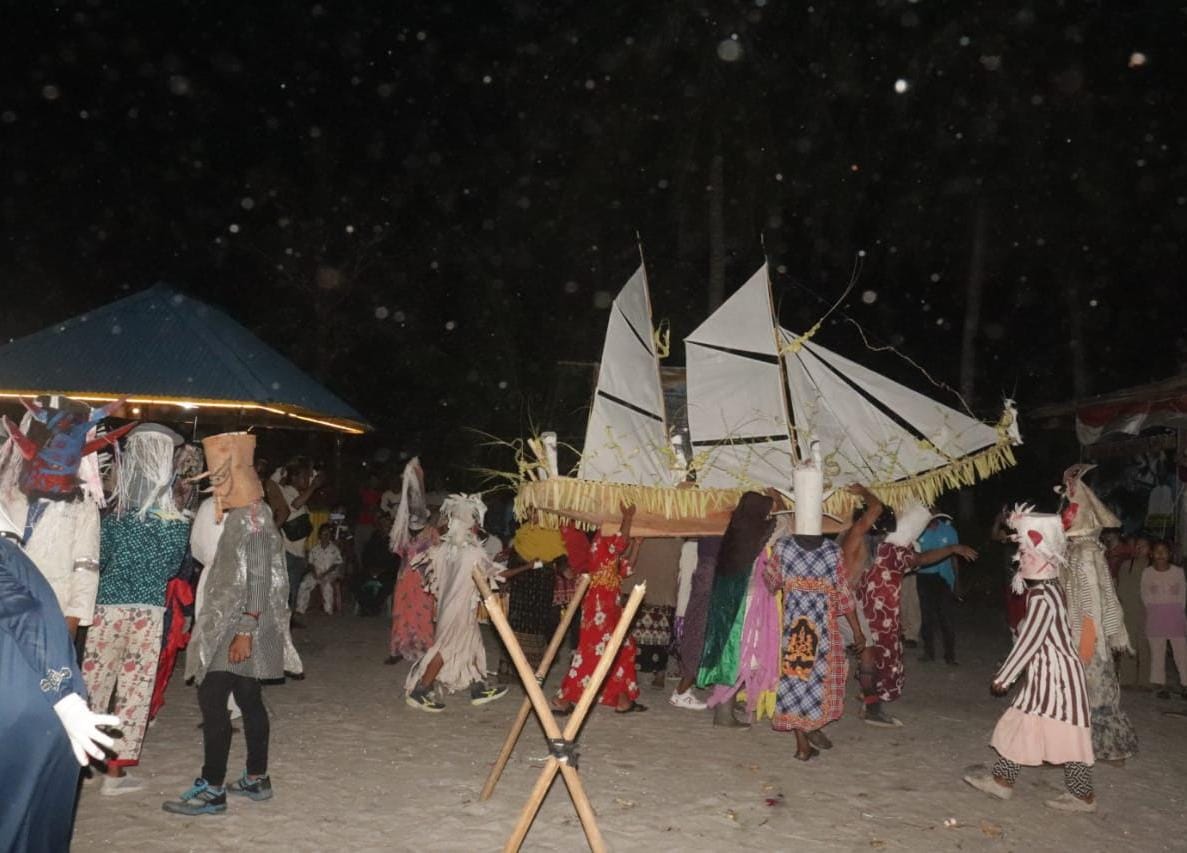
The opening procession of the semah laut tradition symbolically depicts the giving of offerings as provisions for the journey of the miniature boat before it is floated to the sea and the atmosphere of joy of the inhabitants of Karimata Island, both humans and supernatural beings. After the opening night procession, the next morning participants gather again at the same location. They brought their equipment for the procession around Karimata Island and visited several sacred locations. The participants were divided into two groups: one group brought a miniature junk to Tanjung Serunai with Pak Usu as the coordinator, and the other group brought a miniature balai to go around the island. At around 8am, the participants walked along the Palembang River to the jetty. The shallow riverbank made it easy for them to carry the miniature junks and balai on their shoulders to the pier. Upon arrival at the dock, they perform a procession around the dock three times before boarding the boat. This procession seems to be related to the respect for the jetty as the departure location. The first boat sails to Tanjung Serunai, while the second boat circles the island and performs rituals at several sacred locations. The second group's boat trip passes through the coastal waters of the settlements of Lestari coast and Tanjung Ruh hamlets, picking up the land shaman, Saputra, and offering materials.
The first sacred location visited by the boar is Tanah Merah, near the settlement of Tanjung Ruh. This location has a sloping white sand beach, so participants must jump from the boat into the water and walk to the location point with balai and ancak. Tanah Merah is where supernatural cretaures reside on land that are believed to influence the lives of people of Karimata island. Rituals at Tanah Merah involve placing a miniature balai with offering on the ground, burning the material with coconut husks, and chanting players. Black chickens are released into the balai as part of the ritual to get clues about the following year’s sustenance. The color of the offerings eaten by the chicken indicates the tendency of sustenance: black dan yellow for sea sustenance, red and white for land sustenance. After the procession ends, participants return to the boat and continue the journey to the next sacred location.
The next ritual procession is carried out the location of the sacred stone Palang Paoh, a collection of rock in coastal waters whose upper part that comes to the surface. Its elongated shape resembles a crossbar and the part from Tanah Merah, just a few minutes away by the boat. Although beliefs about this rock are nit definitively explained, its shape and large size are often associated with the power of the sea and supernatural sea creatures. Rituals at this rock involve the laying of offerings. On the way to the next location, participant stop at the aters around Tanjung Kalong to pray for safety from the boat without performing a ritual procession on land. The prayers are performed using Islamic teachings. Although the exact reason why this location is sacred is unclear, the presence of rocks and the name Tanjung Kalong which includes the name of the animal, bat, is the reason. This location is often used by the community to put something in order to archieve a goal or fulfil a prayer.
After praying, participant stopped at Kelumpang hamlet, Betok Jaya village, to rest and enjoy the food provided by their hosts. Kelumpang Hamlet is the only settlement from Betok jaya village involved in this year’s semah laut. the minimal involvement of the Betok Jaya villagers was due to a chance in the schedule of the semah laut, which was originally scheduled for May 25 but was moved back to April 4. After resting, participants continued their journey to Karimata Tua Island, which is dominated by rocks that are considered sacred. The island is located close to Karimata Island, separated by shallow waters. Just like at other sacred locations, prayers are performed twice, before and after landing on the island. Rituals involve the release of black chickens and the laying of offerings as offerings to the guardians of Karimata Tua. The prayers combine the traditions of Islamic teachings with traditional offerings.
End and Pledge at Batu Betungkat depicts the end of the semah laut ritual procession on Karimata Island, focusing on two main locations: Batu Betungkat and Tanjung Serunai. The boats participating in the ritual around the island arrive at Batu Betungkat after passing through the waters around Betok Hamlet, the center of Betok Jaya Village. Batu Betungkat is similar to Batu Palang Paoh in Tanah Merah, but smaller and on the coastal edge of Karimata Island. The ritual at Batu Betungkat concludes a series of ritual processions at other sacred locations before heading to Tanjung Serunai. The participants make a pledge and apologize to the supernatural inhabitants if there are any violations. They also acknowledged that violations of taboos would be the business of the supernatural breakers, while the mistakes of fellow humans would be their own business.
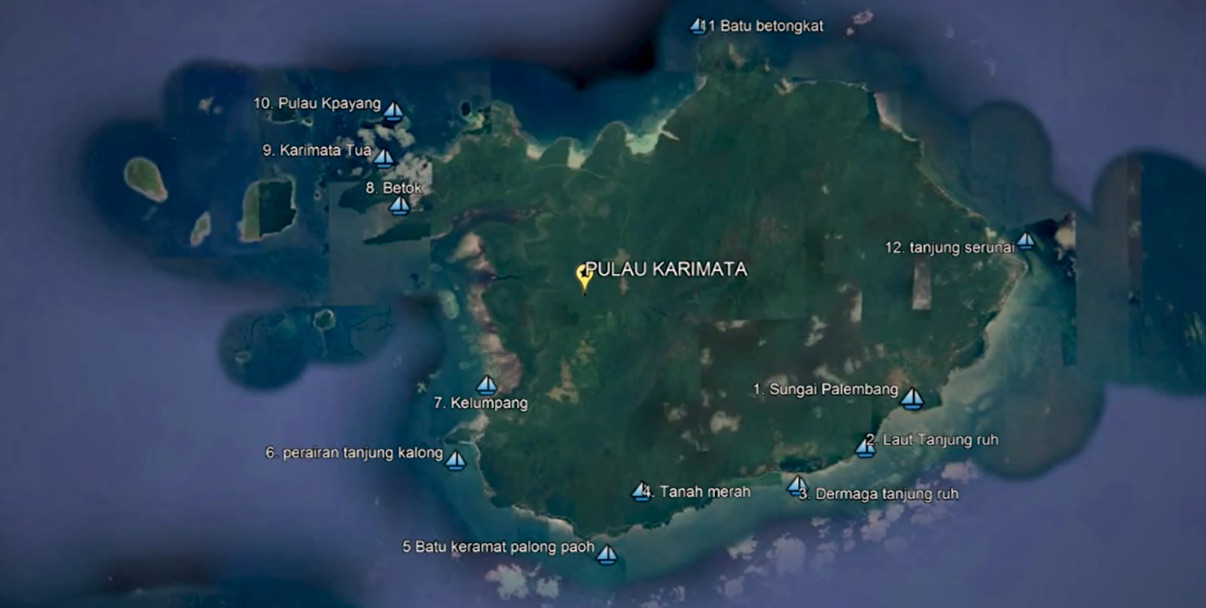
Afterwards, they proceed to Tanjung Serunai for the Petaraan, the final ritual involving the launching of a miniature junk into the sea. The procession begins with careful preparations, including a prayer or mantra from an old woman, an inspection of the miniature jung by Pak Usu, and finally the launching of the miniature jung by a number of young men. The community responds calmly despite the miniature junk collapsing in the middle of the sea, which they believe is a sign of things to come. The atmosphere then changed when the sound of a ship's engine could be heard in the distance, signaling the arrival of the ships participating in the round-the-island tour, who performed welcoming actions by throwing betel nuts and seeds at each other. However, the atmosphere was disrupted when a fishing boat entered the arena and broke the taboo. Although there was initial panic due to this violation, the fishing boat eventually suffered an accident when its engine exploded in the middle of the sea. The vessels participating in the ritual then shifted from welcoming action to rescue action to help the fishing boat involved. This procession illustrates how the semah laut ritual is not only a religious and cultural ceremony, but also reflects the complex relationship between humans.
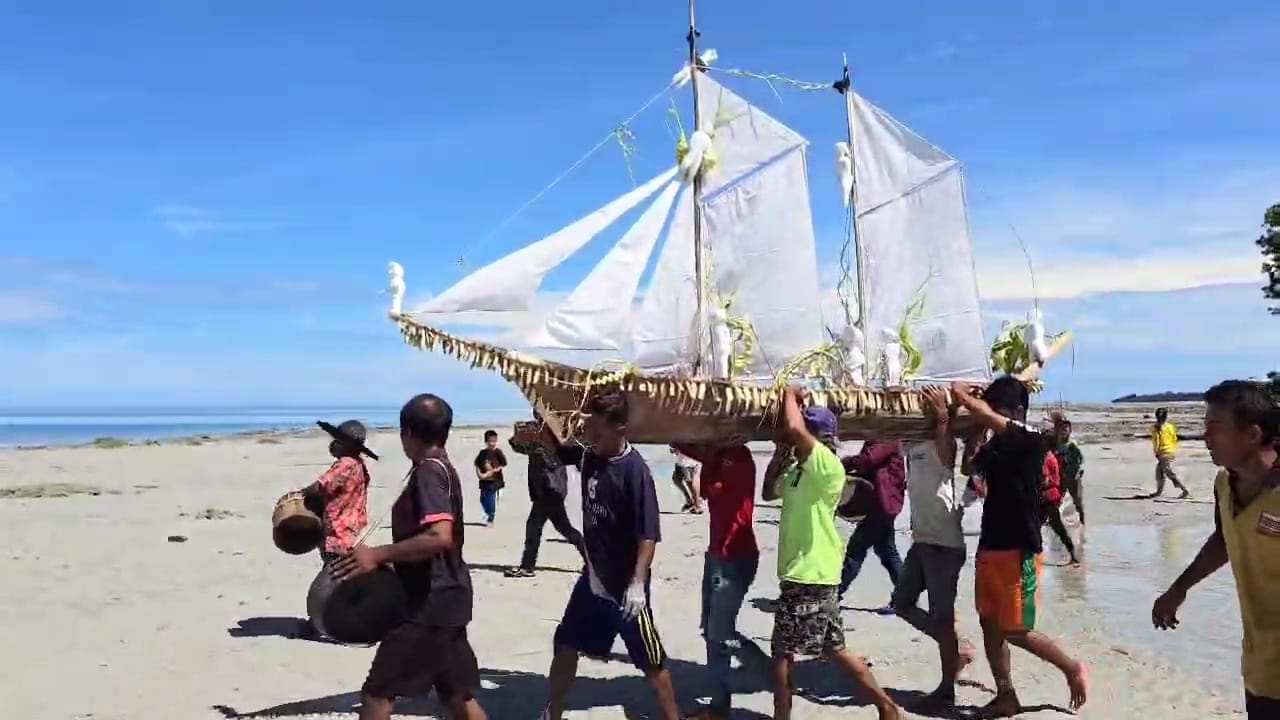
B. Land and Sea in the Semah Laut Tradition
During the Semah Laut procession, there are many deep meanings implied. Semah Laut is a ritual offering to the land (island) and the sea to express gratitude for what they have received so far, the land as a place to live and the sea as a place to find food (Sulistiyono et al., 2023). Land and sea have certain meanings and have a relationship of causality for island communities in explaining the nature of island communities with all the treasures of value and charm both ecologically and socio-culturally. Understanding the semah laut tradition requires understanding the concept of island community life that tends to be open, straight forward and egalitarian. geographical, occupational, and historical aspects (Ruslan, 2017).
Karimata island communities, like other island communities, view the sea and land as a place to maintain their survival and have a relationship that must be maintained for their survival (Kaliky, 2022). People who live in the islands have their own perspective on the sea because the sea full fills their needs (Juliana et al., 2023). The sea has the availability of food sources both animal and vegetable. Therefore, coastal communities in the Indonesian region have a certain perspective on marine resources and marine perception as a form of culture (Widiyawati, 2018). The sea with all its phenomena makes humans must have a boat and all its attributes to manage the sea. Karimata islanders treat the sea specifically as a place to find food. This need creates a culture of fishing that can be interpreted as a social arena where there is interaction between 1) knowledge about fishing, 2) social structures that include sanctions and institutions that exist in a community, 3) forms of facilities categorized as resources that become capital to go to sea (Fitzpatrick & Anderson, 2008; Octavian & Yulianto, 2014).

Apart from the marine life of the Karimata archipelago community, land also has an important meaning. The mainland is where people live and carry out all their life activities, ranging from economy, education, culture and others. The fullfillment of food needs that cannot be obtained at sea is fulfilled from land, such as rice, vegetables and land animal protein. The roles of land and sea are balanced in the life of the Karimata island community. Semah Laut is held as a way of thanking God for what they got during the past year, especially for the catch of fish and its utilization which is considered a blessing by them in the past year and hopes to increase the blessing for the coming year.
The equipment used in the semah laut procession of the semah laut tradition is embodied in the balai miniature house as a presentation of land, and the jung miniature ship as a representation of the sea. The jung resembles the shape of a ship, symbolizing gratitude for what the sea has produced as a source of income. The shape of the jung is made pointed and the back is made slightly wider with the aim that the miniature sailboat that will be sailed at sea has wind thrust that can run forward instead of sideways (Pamungkas & Umami, 2023). The direction of the boat when it is released at sea also has a special meaning. If the jung when released returns to land, this means that the offerings filled in the junk are missing. If it goes directly to the sea, it means that there will be sustenance obtained even though it is not too much. Meanwhile, if the jung when released into the ocean then sinks, this means that the community will get abundant sustenance. The hall, which resembles a house, represents life on land and as a shelter. Land itself is where people live.
The implementation of meaningful traditions on land and sea is symbolized by a miniature house or balai as a place to live for humans and supernatural beings. The hall is made simply which has a pyramid roof, without walls and four poles in each corner and one pole in the middle which will be connected between the poles so that it forms 4 partitions for offerings. As a basis for sustainable living, shelter is the basis of basic human needs and can be made with simplicity tailored to the needs of humans themselves (WP, 2022).
C. Preservation of Semah Laut Tradition for sustainable living
Local wisdom is rooted in local communities that are passed down from generation to generation and systematically used by each generation (Haines et al., 2018). The Semah Laut tradition is a tradition that has been carried out from generation to generation by coastal communities in the Karimata islands, West Kalimantan. This ritual still continue to this day. This shows that this tradition has taken root in the lives of the people in the Karimata Islands. There are several things that cause this tradition to continue to this day. First, the geographical location of the Karimata islands in shallow waters is quite difficult to access. This causes the environment around the Karimata Islands to be preserved, including the culture of the community which has not been polluted by outside cultures. This ritual is also a form of respect for nature, especially the sea as a source of life. In the midst of rampant exploitation of nature, this ritual is a reminder of the importance of maintaining the balance of nature. So that the traditions of the community are still being carried out today.
Second, there is an element of entertainment. The thing that makes the semah laut tradition still sustainable is because of the entertainment in it. The geographical location far from the city center and limited entertainment facilities make people feel interested in enlivening this tradition. This is because in the tradition there are several forms of entertainment including traditional music games and dances that enliven and are full of joy during the procession. Another entertainment activity contained in this procession is that at night the residents run around full of jokes and throw dirty water at anyone they meet. The existence of this entertainment element is the dance power of the community to enliven the semah laut tradition. This makes this tradition continue to be carried out not only as an expression of gratitude but also as a form of community entertainment.
Third, cultural acculturation which is an adaptation of the times. Although rooted in tradition, the semah laut ritual has undergone adjustments without losing its essence. Among these changes is the insertion of religious elements in the procession. In order to be accepted by people who already have a religion, during the procession, in addition to religious elements related to magical things, this procession is also inserted with religious elements, namely accompanying prayers in Islam. This causes this tradition to still be considered relevant to be carried out today.
Fourth, community beliefs. The thing that makes the semah laut tradition still continue to be carried out today is related to the community's belief that what has been obtained so far also has something to do with supernatural powers. Therefore, as an expression of gratitude and thanks, it is done through the implementation of the semah laut tradition. Although the semah laut tradition is still being carried out today, there are several things that become obstacles that can make the lack of existence of this tradition in the future. As for what can be an obstacle and threaten the sustainability of this tradition, including globalization. It is possible that, along with the times, this development also takes place in the Karimata Islands so that it can contaminate the lifestyle of the community. The next thing to worry about is population movement. Not a few Karimata people also go to migrate to other regions, and vice versa, not a few people from other regions move to Karimata Island. This can also change the pattern of behavior of the community, and subsequently the pattern of sustainable living of the Karimata community.
Culture for sustainable living includes shared beliefs and values (Stephenson, 2023). Will Kymlicka said that Indonesians is The God Century, this is because Indonesians have high piety and religiosity (Widiyawati, 2018). This is inseparable from the community's belief in religion, making the community's life inseparable from religious teachings. Maintaining the balance of life of the island community in Tanah Betuah in the tradition of semah laut has an important meaning for the lives of its people. first, maintaining and strengthening human relations with God (Hablum Minallah) while being grateful for the favors that God has given which God has created the universe and everything in it which is none other than to meet human needs in the world from the abundant wealth of the sea and other needs on land. Second, maintaining and strengthening human relationships with each other (Hablum minannas) where in the tradition of semah laut becomes a community meeting place to establish togetherness, mutual cooperation and of course in order to strengthen harmony and unity in social life (Afriansyah & Sukmayadi, 2022). Third, maintaining and strengthening the relationship between humans and their nature (environment) (Hablum minal alam) where the semah laut tradition provides the value of awareness to humans to preserve nature, protect the environment, position nature as friends, brothers and even as parents who must love each other and love nature that has given life and fulfilled their needs as humans, care and be responsible for nature or their environment (Nahuddin et al., 2023; Sakdiyah et al., 2023).
The semah laut tradition is also a means of transforming noble values that have deep and fundamental meanings as humans with God, their neighbors and their environment (the universe) and ancestral cultures to the next generation (children and grandchildren) of course so that the culture or tradition can continue to be preserved and and guaranteed sustainability as a wealth of meaningful traditions or cultures that must and should be proud of. The tradition of semah laut shows that the values of semah laut are gratitude, environmental care, pride in national identity, and social responsibility and are human efforts to decorate (tahalli) to get closer to God. Gratitude to God must be held by the community so that in life it does not make it a greedy man. In addition, customary elders shaman demonstrate their sense of connection to their values and beliefs, as guides, to ensure that their tradition still live on. Elders are therefore respected as wisdom centers of knowledge, and they pass on this knowledge to future generations. The shamans will prepare all the equipment used in the ritual in detail, be it jung, balai or various types of offerings. no stage is missed at all and during the procession the shamans will lead the entire ritual.
Conclusion
The Semah Laut tradition is carried out regularly every year, on April 4th. This ritual lasts for three days, starting from the opening procession, then traveling around visiting areas that are considered sacred while giving offerings that are placed in the hall or jung and the closing procession. The Semah Laut tradition contains many meanings in each process. The symbolic meanings that can be obtained from this Semah Laut tradition are: expression of gratitude that has been received at sea and on land, a form of involvement of the supernatural in the procession, describing the relationship between humans and nature, a form of respect for ancestors or spirits, predicting sustenance and safety that will be obtained in the future, cleansing oneself from negativity, bringing blessings, and strengthening togetherness and mutual cooperation.
The Semah Laut tradition is still being preserved. Its sustainability can be seen from the fact that it is still being carried out and exists today. The reasons for the preservation of this tradition are: The geographical location of the islands is difficult to access, the tradition contains elements of entertainment, cultural acculturation that is relevant to the times, and community beliefs. Although this tradition is still preserved today, there are several things that become obstacles, namely the times and population movements. To overcome this problem there are several efforts that can be made including: inserting traditions in school subject matter, research, and government concern.
Acknowledgements
This work was supported by the Ministry of Education, Culture, Research and Technology of Indonesia fund in 2024 (0067/E5/AL.04/20024).
References
- Afriansyah, A., & Sukmayadi, T. (2022). Nilai kearifan lokal tradisi sedekah laut dalam meningkatkan semangat gotong royong masyarakat pesisir Pantai Pelabuhan Ratu. Jurnal Penelitian Ilmu-Ilmu Sosial, 3(1), 38-54. https://doi.org/10.23917/sosial.v3i1.549
- Amanatin, E. L., Sekarningrum, B., & Supangkat, B. (2024). Ritus Sedekah Laut sebagai Mekanisme Sosial Masyarakat Nelayan Urban di Muarareja Kota Tegal. Ganaya: Jurnal Ilmu Sosial Dan Humaniora, 7(3), 139-152. https://doi.org/10.37329/ganaya.v7i3.3376
- Fauzi, M., Sinar, T. S., Widayati, D., & Tarigan, B. (2021). Ecosophy of Syair Ikan Terubuk. English Language and Literature International Conference (ELLiC) Proceedings,
- Firdaus, A. (2022). Nadiem dorong hidup berkelanjutan melalui Dana Global Pemulihan Budaya. Antara. https://www.antaranews.com/berita/3009045/nadiem-dorong-hidup-berkelanjutan-melalui-dana-global-pemulihan-budaya
- Fitzpatrick, S. M., & Anderson, A. (2008). Island Worlds Apart: Interaction and Remoteness on Seas and Oceans. The Journal of Island and Coastal Archaeology, 3(1), 1-3. https://doi.org/10.1080/15564890801983610
- Haines, J., Du, J. T., & Trevorrow, E. (2018). In Search of Indigenous Wisdom and Interdisciplinary Ways of Learning Together. JOURNAL OF THE AUSTRALIAN LIBRARY AND INFORMATION ASSOCIATION, 67(3), 293-306. https://doi.org/10.1080/24750158.2018.1488358
- Hidayati, K., & Tangkudung, A. (2021). Harmonisasi Pariwisata dengan Konservasi: Suatu Upaya Membangun Pariwisata yang Berkelanjutan Di Kabupaten Kayong Utara. Jurnal Syntax Transformation, 2(01), 105-114. https://doi.org/10.46799/jst.v2i1.205
- Izzah, L., Rochwulaningsih, Y., & Sulistyono, S. T. (2022). Topeng Kona: A Sacred Dance in the Ritual Bersih Desa at Blimbing Village, Bondowoso Regency, East Java, Indonesia. Journal of Maritime and Island Cultures, 11(2), 111-132. https://doi.org/10.21463/jmic.2022.11.2.08
- Jailani, M. S. (2023). Teknik pengumpulan data dan instrumen penelitian ilmiah pendidikan pada pendekatan kualitatif dan kuantitatif. IHSAN: Jurnal Pendidikan Islam, 1(2), 1-9. https://doi.org/10.61104/ihsan.v1i2.57
- Juliana, I., Safitri, N. L., & Fadillah, W. (2023). PEMAKNAAN TRADISI PETIK LAUT BAGI MASYARKAT PESISIR. TUTURAN: Jurnal Ilmu Komunikasi, Sosial dan Humaniora, 1(2), 218-232. https://doi.org/10.47861/tuturan.v1i2.242
- Kaliky, P. I. (2022). Memahami Kehidupan Masyarakat Kepulauan di Maluku Dalam Perspektif Ekologi dan Etnografi Komunikasi. ijd-demos, 4(2). https://doi.org/10.37950/ijd.v4i2.249
- Kemdikbud, P. W. (2022). Mendikbudristek Dorong Konsep Hidup Berkelanjutan Melalui Global Arts and Culture Recovery Fund. Kementrian Pendidikan dan Kebudayaan. https://www.kemdikbud.go.id/main/blog/2022/07/mendikbudristek-dorong-konsep-hidup-berkelanjutan-melalui-global-arts-and-culture-recovery-fund
- Kepel, T. L., Warouw, M. P., Sumolang, S., Daulat, A., Undap, N. I., & Tondo, F. H. (2024). Maritime Culture of Bantik Ethnic Group From North Sulawesi, Indonesia. Journal of Marine and Island Cultures, 13(2), 108-121. https://doi.org/10.21463/jmic.2024.13.2.07
- Komarudin, R. (2023a). Ritual Semah Laut digelar untuk enolak marabahaya. Antara. https://kalbar.antaranews.com/berita/540627/ritual-semah-laut-digelar-untuk-menolak-marabahaya
- Komarudin, R. (2023b). Ritual Semah Laut digelar untuk menolak marabahaya. Antara.
- Kurniadi, B., Minsas, S., & Helena, S. (2023). Pemberdayaan Masyarakat Nelayan Pulau Karimata dalam Kegiatan Monitoring Terumbu Karang. Jurnal Pengabdian kepada Masyarakat Nusantara, 4(4), 4115-4120. https://ejournal.sisfokomtek.org/index.php/jpkm/article/view/1928/1365
- Mellina, Z. M. R., Purwasih, J. H. G., & Hadi, N. (2022). The Impact Of Larung Sesaji Traditional Culture Modification In Tambakrejo Village. Humanus, 21. https://doi.org/https://10.24036/humanus.v21i1.113813
- Mialiawati, I. (2020). The Effect of Globalization on Culture, Information Technology, and Education. PROCEEDING ICTESS (Internasional Conference on Technology, Education and Social Sciences),
- Mildawati, M., & Syahrun, S. (2023). SEJARAH RITUAL TUTURANGIANA ANDALA PADA MASYARAKAT PULAU MAKASSAR KOTA BAU-BAU ABAD XVIII. Sorume: Jurnal Penelitian Sejarah dan Budaya, 1(1), 38-46. http://journal.fib.uho.ac.id/index.php/sorume/article/view/2155/1409
- Nahuddin, Y. E., Laila, K., & Wahyudi, A. R. (2023). Tradisi “Sedekah Bumi” dalam Prespektif Perlindungan dan Pengelolaan Lingkungan Hidup. Journal on Education, 5(4), 14859-14869. https://doi.org/10.31004/joe.v5i4.2559
- Nainggolan, M. C., Naomi, N., Siregar, I., & Purnomo, B. (2023). Menilik Budaya Maritim dari Masyarakat Pesisir Sekitar Pulau Jawa Tahun 1920. Krinok: Jurnal Pendidikan Sejarah dan Sejarah, 2(1), 102-110. https://doi.org/10.22437/krinok.v2i1.24261
- Nurmalasari, E. (2023). Nilai Kearifan Lokal Upacara Petik Laut Muncar Sebagai Simbol Penghargaan Nelayan Terhadap Limpahan Hasil Laut. Jurnal Artefak, 10(1), 43-54. https://doi.org/http://dx.doi.org/10.25157/ja.v10i1.9749
- Octavian, A., & Yulianto, B. A. (2014). Degradasi Kebudayaan Maritim: Sejarah, Identitas, dan Praktik Sosial Melaut di Banten. Masyarakat Indonesia : Jurnal Ilmu Ilmu Sosial Indonesia, 40(2), 159-176. https://doi.org/10.14203/jmi.v40i2.115
- Pamungkas, M. A., & Umami, Z. (2023). Komunikasi Ritual Larung Sesaji Tradisi Sedekah Laut di Kota Tegal. JCommsci-Journal of Media and Communication Science, 6(3), 164-174. https://doi.org/10.29303/jcommsci.v6i3.249
- Purmintasari, Y. D., Nurhakim, I., Rivasintha, E., & Firmansyah, H. (2021). The Arus Kualan Traditional School: Preservation Of Dayak Simpank Environmental And Cultural Heritage. IOP Conference Series: Earth and Environmental Science,
- Radović-Marković, M., Brnjas, Z., & Simović, V. (2019). The impact of globalization on entrepreneurship. Economic Analysis, 52(1), 56-68.
- Ruslan, I. (2017). Religiositas Masyarakat Pesisir:(Studi Atas Tradisi “Sedekah Laut” Masyarakat Kelurahan Kangkung Kecamatan Bumi Waras Kota Bandar Lampung). Al-Adyan: Jurnal Studi Lintas Agama, 9(2), 63-88. https://doi.org/https://dx.doi.org/10.24042/ajsla.v9i2.1415
- Sakdiyah, L., Prateksa, A., Fillah, J. D., Putri, J. A. C., & Indahsari, R. I. (2023). Budaya AGAMA DAN RELASI BUDAYA SEDEKAH LAUT DI PESISIR KOTA PATI. At-Tuhfah, 12(1), 9-18. https://doi.org/10.32665/attuhfah.v12i1.1604
- Sari, M. P., Wijaya, A. K., Hidayatullah, B., Sirodj, R. A., & Afgani, M. W. (2023). Penggunaan metode etnografi dalam penelitian sosial. Jurnal Pendidikan Sains dan Komputer, 3(01), 84-90. https://doi.org/10.47709/jpsk.v3i01.1956
- Stephenson, J. (2023). Culture and Sustainability: exploring stability and transformation with the cultures framework. Springer Nature. https://doi.org/https://library.oapen.org/handle/20.500.12657/62404
- Sulistiyono, S. T., Masruroh, N. N., Ali, I., Rochwulaningsih, Y., & Rinardi, H. (2023). Traditional Knowledge and Origin of Maritime Territorialisation Idea in Indonesia. Journal of Marine and Island Cultures, 12(3), 308-324. https://doi.org/10.21463/jmic.2023.12.3.20
- Swastiwi, A. W., Arman, D., Wibisono, C. F., & Zulha, M. A. (2024). The Symbolic Meaning of Semah Laut From Sea Tribe Panglong Communities in Bintan, Riau Islands. Maritime Continent Fulcrum International Conference,
- Tim Dinas Kepemudaan, O. d. P. (2023). Kalender Event Kalbar 2023. In P. P. K. Barat (Ed.), (pp. 1-47): Dinas Kepemudaan, Olahraga dan Pariwisata.
- Watloly, A. (2012). Konsep diri masyarakat kepulauan. Jurnal Filsafat, 22(2), 120-148. https://doi.org/10.22146/jf.12991
- Widiyawati, A. A. (2018). TRADISI LARUNG SESAJI PUGER UNTUK MEMBENTUK MASYARAKAT POLISENTRIS. Jantra, 13(2), 125-138. http://jantra.kemdikbud.go.id/index.php/jantra/article/view/69/46
- WP, M. A. (2022). Semah Laut Karimata dan Makna Makna Simbolnya. Media Jaya Abadi.
- Yahya, M. I. (2019). Tradisi Sedekah Laut Masyarakat Desa Labuhan Kecamatan Brondong Kabupaten Lamongan Tahun 1990-2015. Avatara: E-Journal Pendidikan Sejarah, 7(1), 1-9. https://ejournal.unesa.ac.id/index.php/avatara/article/view/26710
